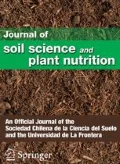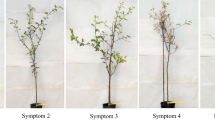Abstract
Small Peruvian coffee producers face low yields per hectare, caused mainly by recent rust outbreaks and by natural crossing of coffee varieties, which are sown without specific order. Coffee rust has drastically reduced areas of susceptible but high-quality cup varieties as caturra, pache, and nacional, which have been replaced by others with high grain weight, but low-quality cup. This study aimed to determine the rooting capacity of sprouts subjected to different concentrations of indole-3-butyric acid (AIB) in three varieties of Coffea arabica, in the San Martín region, Peru. The most appropriate sprout rooting characteristics allowing to propagate rust-tolerant C. arabica plants were evaluated, under the effect of four doses of AIB (0, 1000, 2000, and 3000 ppm) in three coffee varieties (caturra, pache, and nacional), using microtunnels as rooting environments. A completely randomized design, consisting of three repetitions per treatment and six sprouts per repetition, was used. At the end of 50 days, the best rooting result (89%) was obtained with a dose of 2000 ppm of AIB in the caturra variety. The overall results are successful, since there is a conversion rate of sprouts into useful seedlings of more than 85%, if proper handling conditions are implemented. This method of propagation of rust-tolerant C. arabica sprouts by microtunnels enables a mass production of seedlings. The validation of these results could lead to the establishment of entire rust-tolerant coffee farms.


Similar content being viewed by others
References
Aguilera P, Marín C, Oehl F, Godoy R, Borie F, Cornejo PE (2017) Selection of aluminum tolerant cereal genotypes strongly influences the arbuscular mycorrhizal fungal communities in an acidic Andosol. Agric Ecosyst Environ 246:86–93
Barquero M (2013) Recomendaciones para el Combate de la Roya del Cafeto. ICFAE, San José
Bergo CL, Mendes ANG (2000) Propagação vegetativa do cafeeiro (Coffea arabica L.) por meio do enraizamento de estacas. Ciência e Agrotecnologia 24:392–398
Blas R, Cruz R, Bello S et al (2011) Informe del Proyecto: Estudio de variabilidad genética del café y establecimiento de un banco de germoplasma en la selva peruana. ESERGRAF, Lima
Blazich FA (1988) Chemicals and formulations used to promote adventitious rooting. In: Davis TD, Haissig BE, Sankhla N (eds) Adventitious root formation in cuttings. Dioscorides Press, Portland, pp 132–149
Brookfield H, Padoch C (2007) Managing biodiversity in spatially and temporally complex agricultural landscapes. In: Jarvis DI, Padoch C, Cooper HD (eds) Managing biodiversity in agricultural ecosystems. Columbia University Press, New York, pp 338–361
Charrier A, Eskes AB (2004) Botany and genetics of coffee. In: Wintgens JN (ed) Coffee: growing, processing, sustainable production: a guidebook for growers, processors, traders, and researchers. Wiley-VCH Verlag GmbH & Co., Weinheim, pp 25–26
De Muner LH (2011) Sostenibilidad de la Caficultura Arábica en el Ámbito de la Agricultura Familiar en el Estado de Espírito Santo – Brasil. Doctoral Thesis, University of Córdoba, Spain
FAO (2008) High-level conference on world food security: the challenges of climate change and bioenergy. FAO, Rome
García Pineda AF (2013) Vulnerabilidad y adaptación al cambio climático en la caficultura colombiana. In: Ulloa A, Prieto-Rozo AI (eds) Culturas, conocimientos, políticas y ciudadanías en torno al cambio climático. Universidad Nacional de Colombia, Bogotá, pp 107–142
Gaspar T, Hofinger M (1988) Auxin metabolism during adventitious rooting. In: Davis TD, Haissig BE, Sankhla N (eds) Adventitious root formation in cuttings. Dioscorides Press, Portland, pp 117–131
Grange R, Loach K (1985) The effect of light on the rooting of leafy cuttings. Sci Hortic 27:105–111
Hartman HT, Kester DE (1997) Propagación de plantas: principios y prácticas. Editorial Continental, México D.F
Hiroshi G, Sera T, Batista I, Shiguer D (2009) Resistance to leaf rust in coffee cultivars. Coffee Sci 5:59–66
ICO (2013) International coffee organization - annual review 2011/12. ICO, London
Instituto Nacional de Estadística e Informática del Perú (2013) Resultados definitivos: IV Ceso Nacional Agropecuario 2012. Ministerio de Agricultura y Riego, Lima
Jesús AMS (2003) Propagação vegetativa do cafeeiro (Coffea arabica L.). Doctoral Thesis, Federal University of Lavras, Lavras, Brazil
Junta Nacional del Café de Perú (2013) Plan de Contingencia para el Control de la Roya del Café en el 2013. Consejo Nacional del Café, Lima
Lashermes P, Combes MC, Robert J, Trouslot P, D’Hont A, Anthony F, Charrier A (1999) Molecular characterisation and origin of the Coffea arabica L. genome. Mol Gen Genet 261:259–266
Leakey RRB, Mesen F, Tchoundjeu Z et al (1990) Low technology techniques for the vegetative propagation of tropical trees. Commonw For Rev 69:247–257
Loach K (1988) Controlling environmental conditions to improve adventitious rooting. In: Davis TD, Haissig BE, Sankhla N (eds) Adventitious root formation in cuttings. Dioscorides Press, Portland, pp 248–273
Lovell PH, White J (1986) Anatomical changes during adventitious root formation. In: Lackson MB (ed) New root formation in plants and cuttings. Martinus Nijhoff Publisher, Dordrecht, pp 111–140
Maluf MP, Silvestrini M, Machado de Campos L, Guerreiro O, Colombo CA (2005) Genetic diversity of cultivated Coffea arabica inbred lines assessed by RAPD, AFLP and SSR marker systems. Sci Agric 62:366–373
Mesen F (1993) Vegetative propagation of central American hardwoods. University of Edinburgh, Scotland, Doctoral Thesis
Ministerio de Agricultura y Riego (2014a) Plan Nacional de Renovación de Cafetales. Dirección General de Competitividad Agraria, Lima
Ministerio de Agricultura y Riego (2014b) Origen y distribución geográfica del cafeto. Dirección General de Competitividad Agraria, Lima
Moe R, Andersen AS (1988) Stockplant environment and subsequent adventitious rooting. In: Davis TD, Haissig BE, Sankhla N (eds) Adventitious root formation in cuttings. Dioscorides Press, Portland, pp 214–234
Palomino C, López C, Espejo R, Mansilla R, Quispe J (2014) Evaluación de la diversidad genética del café (Coffea arabica L.) en Villa Rica (Perú). Ecología Aplicada 13:129–134
Petchers S, Harris S (2008) The roots of the coffee crisis. In: Bacon CM, Méndez VE, Gliessman SR, Goodman D, Fox JA (eds) Confronting the coffee crisis: fair trade, sustainable livelihoods and ecosystems in Mexico and Central America. MIT Press, Cambridge, pp 43–66
Phillips J (1975) Apical dominance. Annu Rev Plant Physiol 26:341–367
Phillips A, Stolton S (2008) Protected landscapes and biodiversity values: a review. In: Amend T, Brown J, Kothari A, Phillips A, Stolton S (eds) Protected landscapes and agrobiodiversity values. IUCN-GTZ, Heidelberg, pp 8–21
Ramírez JE (1996) Poda y manejo de Coffea arabica L. Instituto del Café de Costa Rica, San José
Ruíz-Solsol H, Mesen F (2010) Efecto del ácido indolbutírico y tipo de estaquilla en el enraizamiento de sacha inchi (Plukenetia volubilis L.). Agronomía Costarricense 34:259–267
Snedecor GW, Cochran WG (1980) Statistical methods. Iowa State University Press, Iowa
Tran HT, Lee LS, Furtado A, Smytha H, Henrya RJ (2016) Advances in genomics for the improvement of quality in coffee. J Sci Food Agric 96:3300–3312
Turbay S, Nates B, Jaramillo F, Vélez JJ, Ocampo OL (2013) Adaptación a la variabilidad climática entre los caficultores de las cuencas de los ríos Porce y Chinchiná, Colombia. Investigaciones Geográficas 85:95–112
Veierskov B (1988) Relations between carbohydrates and adventitious root formation. In: Davis TD, Haissig BE, Sankhla N (eds) Adventitious root formation in cuttings. Dioscorides Press, Portland, pp 70–78
Veierskov B, Andersen AS (1982) Dynamics of extractable carbohydrates in Pisum sativum. III. The effect of IAA and temperature on content and translocation of carbohydrates in pea cuttings during rooting. Physiol Plant 55:179–182
Zobel B, Talbert J (1988) Técnicas de mejoramiento genético de árboles forestales. Ed. Limusa, México D.F
Funding
To the “Programa Nacional de Inovación Agraria – PNIA” for funding this research work in the framework of the activities of the project “Biofertilización y bioprotección de plantas clonales de café (Coffea arabica) con micorrizas arbusculares en la Región San Martín,” according to Contract No. 23-2015-INIA-PNIA/UPMSI/IE. To the project “Generación de tecnologías de adaptación a los efectos negativos del cambio climático como un modelo sostenible y exitoso de la caficultura en la región San Martín” (No. 20-2018-FONDECYT-BM-IADT-AV), for funding the doctoral thesis “Efectos de la inoculación de micorrizas arbusculares sobre la tolerancia a roya en clones de café (Coffea arabica L.) var. caturra y pache en Moyobamba, Perú.” C.M. thanks the Universidad de O’Higgins postdoctoral fund.
Author information
Authors and Affiliations
Corresponding author
Ethics declarations
Conflict of Interest
The authors declare that they have no conflict of interest.
Additional information
Publisher’s note
Springer Nature remains neutral with regard to jurisdictional claims in published maps and institutional affiliations.
Rights and permissions
About this article
Cite this article
Vallejos-Torres, G., Arévalo, L.A., Ríos, O. et al. Propagation of Rust-Tolerant Coffea arabica L. Plants by Sprout Rooting in Microtunnels. J Soil Sci Plant Nutr 20, 933–940 (2020). https://doi.org/10.1007/s42729-020-00180-7
Received:
Accepted:
Published:
Issue Date:
DOI: https://doi.org/10.1007/s42729-020-00180-7




